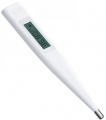Measurement accuracy
The extent to which a device deviates from the actual temperature during measurements determines its accuracy. Even the least accurate electronic medical thermometers today have a maximum deviation of 0.3 °C, sufficient for everyday and basic medical use. Common models offer even higher accuracy, with deviations as low as
0.1 °C or
0.2 °C, making the pursuit of maximum accuracy necessary only in specific scenarios.
Reading memory
The number of results the thermometer can store in memory. The ability to
"remember" the results of previous measurements can be very convenient in some cases — in particular, it allows you to accurately track changes in temperature over time. The most advanced models are capable of storing several dozen readings in memory.
Display backlight
Availability of
backlight at own display of the thermometer. This feature allows you to easily see the screen readings in low light and even in complete darkness.
Waterproof case
The presence in the design
waterproof case. This feature allows you to thoroughly wash the thermometer; this is especially important for multi-application models (see above) and when using the same device for multiple patients.
Power source
Type of batteries used in thermometers.
— AA. The ubiquitous battery, commonly found everywhere batteries are sold, operates at 1.5 volts, making it widely accessible.
— AAA. The batteries, which are a compact alternative to AA batteries with the same 1.5V voltage, are widely used and suitable for small devices.
— CR2032. One of the most popular types of batteries, with a diameter of 20 mm and a thickness of 3.2 mm. Actual for use in compact devices.
